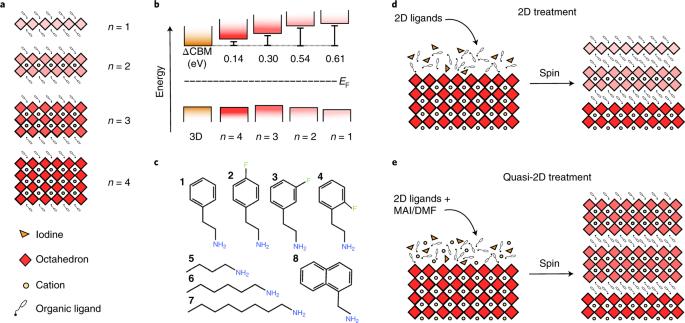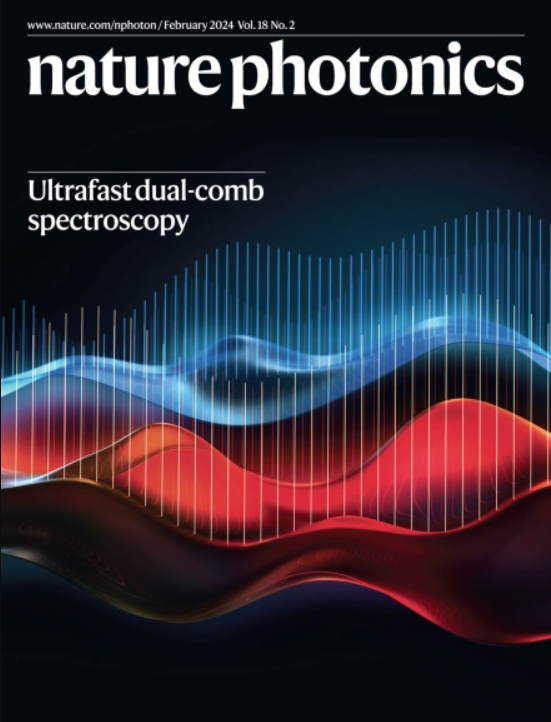Quantum-size-tuned heterostructures enable efficient and stable inverted perovskite solar cells
IF 32.9
1区 物理与天体物理
Q1 OPTICS
引用次数: 125
Abstract
The energy landscape of reduced-dimensional perovskites (RDPs) can be tailored by adjusting their layer width (n). Recently, two/three-dimensional (2D/3D) heterostructures containing n = 1 and 2 RDPs have produced perovskite solar cells (PSCs) with >25% power conversion efficiency (PCE). Unfortunately, this method does not translate to inverted PSCs due to electron blocking at the 2D/3D interface. Here we report a method to increase the layer width of RDPs in 2D/3D heterostructures to address this problem. We discover that bulkier organics form 2D heterostructures more slowly, resulting in wider RDPs; and that small modifications to ligand design induce preferential growth of n ≥ 3 RDPs. Leveraging these insights, we developed efficient inverted PSCs (with a certified quasi-steady-state PCE of 23.91%). Unencapsulated devices operate at room temperature and around 50% relative humidity for over 1,000 h without loss of PCE; and, when subjected to ISOS-L3 accelerated ageing, encapsulated devices retain 92% of initial PCE after 500 h. A scheme to control the confinement within 2D/3D perovskite heterostructures results in stable, efficient inverted perovskite solar cells.

量子尺寸调谐异质结构使高效稳定的倒钙钛矿太阳能电池成为可能
可以通过调整层宽(n)来定制还原维包晶石(RDP)的能谱。最近,含有 n = 1 和 2 RDP 的二维/三维(2D/3D)异质结构已生产出功率转换效率为 25% 的过氧化物太阳能电池(PSC)。遗憾的是,由于二维/三维界面上的电子阻滞,这种方法无法转化为反向 PSC。在此,我们报告了一种在二维/三维异质结构中增加 RDP 层宽度的方法,以解决这一问题。我们发现,体积较大的有机物形成二维异质结构的速度更慢,从而导致更宽的 RDP;而且配体设计的微小改动会诱导 n ≥ 3 RDP 的优先生长。利用这些见解,我们开发出了高效的倒置 PSC(经认证的准稳态 PCE 为 23.91%)。未封装器件可在室温和约 50%的相对湿度下工作 1000 多小时,而不会损失 PCE;当经受 ISOS-L3 加速老化时,封装器件在 500 小时后仍能保持 92% 的初始 PCE。控制二维/三维包晶异质结构内的约束的方案可产生稳定、高效的倒置包晶太阳能电池。
本文章由计算机程序翻译,如有差异,请以英文原文为准。
求助全文
约1分钟内获得全文
求助全文
来源期刊

Nature Photonics
物理-光学
CiteScore
54.20
自引率
1.70%
发文量
158
审稿时长
12 months
期刊介绍:
Nature Photonics is a monthly journal dedicated to the scientific study and application of light, known as Photonics. It publishes top-quality, peer-reviewed research across all areas of light generation, manipulation, and detection.
The journal encompasses research into the fundamental properties of light and its interactions with matter, as well as the latest developments in optoelectronic devices and emerging photonics applications. Topics covered include lasers, LEDs, imaging, detectors, optoelectronic devices, quantum optics, biophotonics, optical data storage, spectroscopy, fiber optics, solar energy, displays, terahertz technology, nonlinear optics, plasmonics, nanophotonics, and X-rays.
In addition to research papers and review articles summarizing scientific findings in optoelectronics, Nature Photonics also features News and Views pieces and research highlights. It uniquely includes articles on the business aspects of the industry, such as technology commercialization and market analysis, offering a comprehensive perspective on the field.
 求助内容:
求助内容: 应助结果提醒方式:
应助结果提醒方式:


